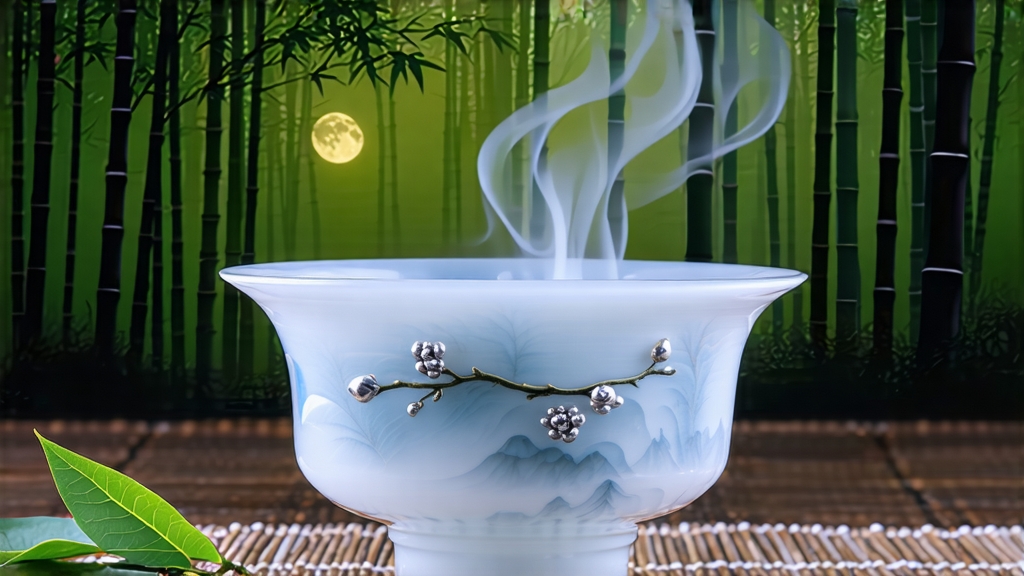
Bai Hao Yin Zhen—“Silver Needle of White Down”—is the most aristocratic expression of China’s white-tea family. While green tea commands the spotlight for freshness and pu-erh for age-worthiness, Silver Needle whispers its virtues in a language of moonlight, pine breeze, and the faint sweetness of mountain springs. To understand it is to step into a centuries-old dialogue between terroir and time, where minimal intervention becomes the highest form of craftsmanship.
Historical echoes
White tea as a style was first recorded in the Song dynasty (960-1279), yet the name “Yin Zhen” appears only during the late Qing, when Fuding and Zhenghe counties in Fujian province began selecting the unopened buds of the Da Bai cultivar for tribute. Legend claims that pickers worked by the light of the full moon so the buds would not wilt in the sun; the truth is more pragmatic—cool night air slows oxidation, preserving the pale cilia that cloak each tip in silvery down. Exported through the port of Fuzhou in the 1890s, Silver Needle quickly captivated European courts, earning the nickname “Chinese Silver Tips” and prices higher than black tea from Assam. Today it remains the only Chinese tea whose grade is judged almost entirely on the percentage of intact buds, a standard that would be impossible without the cool maritime climate and red granitic soils of northern Fujian.
From garden to leaf
Authentic Bai Hao Yin Zhen comes exclusively from two protected geographical origins: Fuding, where the cultivar Fuding Da Bai yields long, plump buds with a mango-like amino sweetness, and Zhenghe, whose Zhenghe Da Bai produces slightly stouter buds noted for orchid fragrance and deeper, hay-like notes. Picking begins in mid-March when the bud reaches 2.5–3 cm but before the first leaf unfurls. Experienced pickers can gather only 500 g of fresh buds in a day; 30,000 buds—enough to fill a single 500 g tin—must be plucked one by one, always with the thumbnail, never a twist, to avoid bruising the fragile surface cells.
Crafting nothing into something
The processing of Silver Needle is famously described as “two witherings and one gentle bake,” yet within that simplicity lies extraordinary precision. First, the buds are spread on bamboo trays in a shaded pavilion for 36–48 h, allowing moisture to fall from 78 % to 35 %. During this “living wither” enzymes convert proteins into free amino acids, building the tea’s signature umami-sweet core. Next comes the “sun-wither,” a 20-minute exposure to early-morning light that activates a mild photo-oxidation, turning the down a brighter silver and coaxing out apricot lactones. Finally, the buds are stacked 3 cm deep in bamboo baskets and charcoal-baked at 40 °C for half an hour; the temperature must never exceed the skin temperature of a child’s forehead, say the masters, or the velvet down will yellow and the taste flatten. No rolling, no fixing, no shaping—just the bud surrendering its water while holding onto its soul.
Chemistry in repose
Laboratory analysis shows that properly stored Silver Needle contains 5.8 % L-theanine, among the highest levels in any tea, explaining the silky mouthfeel and lingering sweet aftertaste. Caffeine averages 4.2 %, comparable to green tea, yet the absence of catechin oxidation means astringency is negligible. Instead, the cup offers a delicate matrix of floral aldehydes, trans-β-ionone (violet), and hotrienol (linden honey), compounds that evolve dramatically with age. Connoisseurs often cellar small batches for five to fifteen years; as the chlorophyll slowly degrades, the liquor turns from pale champagne to deep amber, and the aroma shifts from fresh lilies to dried longan, sandalwood, and the unmistakable scent of old Chinese medicine chests.
The art of brewing
Silver Needle is forgiving but not foolish; it rewards attention without punishing innocence. Begin with 3 g of buds—about two heaping teaspoons—in a 150 ml glass gaiwan. Water should be 85 °C; hotter temperatures extract bitter caffeine, while cooler water leaves the buds dormant. After a five-second rinse to awaken the down, infuse for 45 s. The first pour releases a pale liquor the color